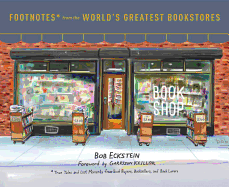
| Publisher: | Clarkson Potter | |
| Genre: | Biography & Autobiography, Form, Literary Criticism, Personal Memoirs, Social History, Business & Economics, Commerce, History, Books & Reading, Humor | |
| ISBN: | 9780553459272 | |
| Pub Date: | October 2016 | |
| Price: | $22 |
| Biography & Memoir |
by Bob Eckstein
Illustrator, writer and cartoonist Bob Eckstein (The History of the Snowman) was inspired to paint "the greatest bookstores of the world" after he contributed a piece about bookshops to the New Yorker. Amassing hundreds of quotes and insights into the value of independent stores from owners and employees, writers, celebrities and readers, Eckstein presents beautiful illustrations of 75 beloved shops, pairing them with charming quotes, stories and facts particular to each locale. Some stores are familiar: Strand Book Store in New York City, Elliott Bay Book Company in Seattle and Shakespeare and Company in France. Others, however, are off the beaten path: the obscure Librairie Avant-Garde in China, Giggles of India and Words on the Water in England. Add a foreword by Garrison Keillor, a bit of history and anecdotes about great names in literature--like Hemingway, J.D. Salinger and Alice Munro--along with presidents and readers of all stripes who've wandered among the shelves, and this beautifully presented collection celebrates indie bookshops and those who love them. --Kathleen Gerard, blogger at Reading Between the Lines

| Publisher: | DK Books | |
| Genre: | Reference, Science, Cosmology, General, History, World | |
| ISBN: | 9781465454430 | |
| Pub Date: | October 2016 | |
| Price: | $50 |
| History |
by DK
"Big history" aims to knit our knowledge about the universe and life on Earth into an orderly context. It blends the social, natural and physical sciences, and looks for cause-and-effect relationships between evolutionary events. Big History, produced in association with the Big History Institute at Macquarie University in Australia, collects these ideas into a big book.
It identifies eight "thresholds" in the development of life as we know it, beginning with the Big Bang and moving through nearly 14 billion years to our modern industrial age. Each threshold is marked by its "Goldilocks conditions"--the particular, just-right combination of circumstances that set up the next evolutionary leap--as Big History explores it in words, maps, diagrams and photographs. The book features a 60-page "Timelines of World History" section in addition to topic-specific timelines on nearly every page. Although the material it covers becomes more specific and specialized as it moves closer to the current era, Big History is, quite literally, about the big picture. --Florinda Pendley Vasquez, blogger at The 3 R's Blog: Reading, 'Riting, and Randomness
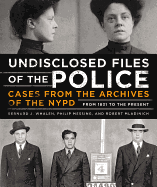
| Publisher: | Black Dog & Leventhal | |
| Genre: | Photography, True Crime, United States, General, Subjects & Themes, Organized Crime, 20th Century, Murder, History, Social Science, Historical | |
| ISBN: | 9780316391238 | |
| Pub Date: | September 2016 | |
| Price: | $40 |
| History |
by Bernard J. Whalen, Philip Messing, Robert Mladinich

| Publisher: | National Geographic Society | |
| Genre: | Earth Sciences, Science, Cosmology, General, Popular Culture, Social Science, Astronomy | |
| ISBN: | 9781426217272 | |
| Pub Date: | September 2016 | |
| Price: | $30 |
| Starred | Science |
by Neil deGrasse Tyson
In StarTalk, Neil deGrasse Tyson has compiled the best segments of his podcast and television show into a rich compendium of entertaining and informative sections on a vast array of subjects. If you've ever wondered what astronauts eat while in space or where their waste products go, whether planting thousands of trees would help offset carbon emissions, how a roller coaster works, or if we could survive a magnetic polar reversal, then Tyson has the answer for you. Geared toward the young, but intriguing for all ages, these solid snippets of science-backed data will satisfy the curiosity of those in search of a quick answer while piquing the interest of those who wish to investigate further. Color photographs and graphics enhance every page, further stimulating the reading experience. StarTalk is so filled with details on everything from salt to sex to comedy and religion that it's best read in short sections, in order to appreciate the magnitude of information it contains. --Lee E. Cart, freelance writer and book reviewer

| Publisher: | Prospecta Press | |
| Genre: | Technology & Engineering, Agronomy, Science, Agriculture, Environmental Science | |
| ISBN: | 9781632260574 | |
| Pub Date: | September 2016 | |
| Price: | $45 |
| Science |
by Cary Fowler, photographs by Mari Tefre and Jim Richardson
Built into a remote Norwegian mountainside, a concrete vault houses sealed boxes kept behind multiple locked doors, monitored by electronic security, safeguarding the key to human survival. What sounds like dystopian fiction is actually present-day reality. Seeds on Ice is the true, far-out story of the Svalbard Global Seed Vault, written with authority by Cary Fowler, inaugural director of the Global Crop Diversity Trust.
Climate change has introduced new complexity to already challenging agricultural issues. The vault and its hundreds of millions of seeds exist thanks to farmers and scientists joining together worldwide and persisting in their mission to rescue future food supplies.
Svalbard is also home to the northernmost permanent settlement in the world, where polar bears outnumber humans two to one. Fowler shares the history and complexity of the vault and its surrounding community with straightforward prose, supported beautifully by vivid photographs from Mari Tefre and Jim Richardson. --Lauren O'Brien of Malcolm Avenue Review
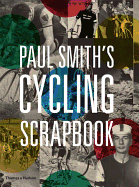
| Publisher: | Thames & Hudson | |
| Genre: | Photography, Cycling, General, Subjects & Themes, Sports & Recreation, History, Sports | |
| ISBN: | 9780500292365 | |
| Pub Date: | June 2016 | |
| Price: | $50 |
| Sports |
by Paul Smith with Richard Williams
British fashion designer Paul Smith once aspired to be a professional cyclist, and his love for the sport has persisted over the decades. Paul Smith's Cycling Scrapbook presents assorted ephemera accompanied by Smith's casual commentary, with a brief foreword by Scottish cyclist David Millar.
Smith has an impressive collection of cycling jerseys, pennants, advertisements and publications specific to professional road and track racing. Chapter headings present themes and artifacts, including racing personalities, events like grand tours and one-day classics, Smith's own bicycles and what he refers to as "the look." He admires the individual histories of heroes like Fausto Coppi, Jacques Anquetil and Eddy Merckx, and Smith's friends among contemporary racing stars, including Mark Cavendish and Bradley Wiggins. Throughout, Smith's tone is conversational and self-effacing, even as he is honored to design the 2013 Giro d'Italia's maglia rosa (leader's jersey).
Visually stunning and wide-ranging, Paul Smith's Cycling Scrapbook elegantly marries Smith's admiration for the heroes of road and track cycling with his passion for design. --Julia Jenkins, librarian and blogger at pagesofjulia

| Publisher: | Sterling | |
| Genre: | Technology & Engineering, Industrial Design, Antiques & Collectibles, Packaging, Popular Culture, Technical & Manufacturing Industries & Trades | |
| ISBN: | 9781454920786 | |
| Pub Date: | October 2016 | |
| Price: | $21.95 |
| Reference & Writing |
by Peter Weil, Paul Robert
Paul Robert and Peter Weil share a passionate love for the typewriter, and their homage to this frequently cherished writing instrument clearly illustrates that love. Filled with gorgeous photographs of typists and typewriters from the authors' personal collections, and with fascinating facts about the device's invention and how it rose to popularity, Typewriter: A Celebration of the Ultimate Writing Machine is a perfect gift for history aficionados, writers and vintage-loving hipsters alike.
It offers photographs and details of particular models like the Maskelyne, the Rem-Sho and the Sun Standard, as well as stories of female typists entering the workforce and biographical snippets about important typewriter innovators such as woodcarver Peter Mitterhofer of Austria and theologian James Bartlett Hammond of Boston. Robert and Weil trace a clear progression of more than 100 years of typewriter history.
The perfect way to reminisce about the pre-computer days, or marvel at how far and fast technology has adapted, Typewriter is a lovely way to while away an afternoon. --Jessica Howard, blogger at Quirky Bookworm

| Publisher: | Agate Bolden | |
| Genre: | Biography & Autobiography, Photography, Jazz, Music, Genres & Styles, Celebrity, Subjects & Themes, Artists, Architects, Photographers, Individual Composer & Musician | |
| ISBN: | 9781932841985 | |
| Pub Date: | October 2015 | |
| Price: | $35 |
| Starred | Performing Arts |
by A. Alyce Claerbaut and David Schlesinger, editors
Within the last 20 years, the true genius of Billy Strayhorn has come to the forefront of jazz criticism and scholarship. Billy Strayhorn: An Illustrated Life, edited by his niece A. Alyce Claerbaut and David Schlesinger, gathers an insightful collection of essays, photographs and interviews on the life of this jazz great.
Strayhorn, a short, ebullient, gay, African American pianist, was a giant among jazz arrangers and composers from the 1930s until his untimely death from esophageal cancer at the age of 51 in 1967. This gorgeous coffee-table book contains candid photos of the artist at work and at play, including a never-before published photograph of a handwritten "Take the A Train" score that Strayhorn wrote for the Duke Ellington Orchestra. Fans of Strayhorn and his particular era of jazz music will be delighted with every page, filled with imagery and words that attempt to explain Strayhorn's striking talent and impact. --Rob LeFebvre, freelance writer/editor
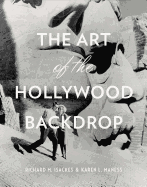
| Publisher: | Regan Arts | |
| Genre: | Design, Art, General, Performing Arts, Film & Video | |
| ISBN: | 9781941393086 | |
| Pub Date: | November 2016 | |
| Price: | $100 |
| Starred | Performing Arts |
by Richard M. Isackes, Karen L. Maness
In The Art of the Hollywood Backdrop, Richard M. Isackes and Karen L. Maness pay tribute to scenic artists, the craftspeople who hand-painted the backdrops (or backings), for Hollywood films. They may have started as immense white expanses of cotton muslin, but by the time the artists were done with them, the fabrics depicted clouds above The Petrified Forest, the faces on Mount Rushmore in North by Northwest or translucent botanical gardens in Lemony Snicket's A Series of Unfortunate Events.
Amid reminiscences and stories of the profession's dangers--one artist fell from an elevated platform and died while working on 2001's Planet of the Apes--the authors celebrate a craft that digital technology is slowly supplanting and showcase the achievements of industry pioneers. This handsome volume includes hundreds of movie stills and many insider tidbits that film obsessives will love. Among the latter: the scene of Rome behind George Clooney in the 2016 movie Hail, Caesar! is the original backdrop from 1959's Ben-Hur. --Michael Magras, freelance book reviewer

| Publisher: | Black Dog & Leventhal | |
| Genre: | History & Criticism, Rock, Music, Instruction & Study, Appreciation, Genres & Styles, General, Lyrics, Individual Composer & Musician | |
| ISBN: | 9780316317740 | |
| Pub Date: | October 2016 | |
| Price: | $50 |
| Performing Arts |
by Philippe Margotin, Jean-Michel Guesdon
Some stories are well known, such as Keith Richards's anecdote about having no memory of composing "(I Can't Get No) Satisfaction" in his sleep but luckily a tape recorder on his nightstand captured it--plus 40 minutes of snoring. Other revelations are more obscure, such as how "Beast of Burden" started as a song Richards wrote about himself being a burden on the band due to his drug habit.
Because they didn't interview the band members, Margotin and Guesdon use previously published information and often resort to speculation about the inspiration for each song. But the authors' thoroughness, along with more than 500 photographs, make this a handsome gift for Stone addicts. --Elyse Dinh-McCrillis, blogger at Pop Culture Nerd
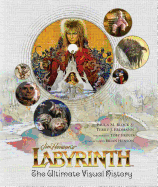
| Publisher: | Insight Editions | |
| Genre: | History & Criticism, Art, Popular Culture, General, Performing Arts, Film & Video | |
| ISBN: | 9781608878109 | |
| Pub Date: | October 2016 | |
| Price: | $45 |
| Performing Arts |
by Paula M. Block, Terry J. Erdmann
Lovers of fantasy and puppetry, rejoice: Paula M. Block and Terry J. Erdmann (Star Trek: The Original Series 365) have compiled an exhaustive and exquisitely arranged compendium of tales and memorabilia in Jim Henson's Labyrinth: The Ultimate Visual History for the 1986 film's 30th anniversary.
This is a truly behind- and in-the-scenes look at a film that has maintained a pull on audiences for decades. With sketches, interviews with cast and crew and thorough research, Block and Erdmann explore the genesis of the film, its script, its puppets, the ins and outs of its filming, and the ups and downs of its reception. It's at once dazzling and engrossing. The collection is studded with extras that add texture and delight: inserts, posters, scripts, memos, original art and stunning photography. The result is a tribute to Henson, to Labyrinth and to the people who made it possible, a rich shrine to the film's enduring legacy. --Katie Weed, freelance writer and reviewer
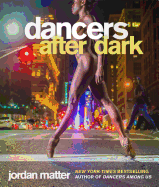
| Publisher: | Workman | |
| Genre: | Photography, Dance, General, Subjects & Themes, Nudes, Erotica, Performing Arts, Sports, Collections, Catalogs, Exhibitions | |
| ISBN: | 9780761189336 | |
| Pub Date: | October 2016 | |
| Price: | $19.95 |
| Art & Photography |
by Jordan Matter
Photographer Jordan Matter, author of Dancers Among Us, takes his subjects out of the studio again in Dancers After Dark, this time after sunset and without their clothes. Captioned with the location and exact time each photograph was taken, the images here are stunning in their variety and ingenuity. Matter shoots his dancers all over the world, often in highly public places like the steps of the New York Public Library or a train platform in Berlin, as well as more deserted locales, like a sheep pasture in England's Cotswolds or the middle of an icy river in Steamboat Springs, Colo. The grace and athleticism of the human form is on full display here, and each photograph demonstrates daring, vulnerability, teamwork and creativity. Behind-the-scenes stories also provide a peek into the breathless process behind notable photographs. Dancers After Dark is a riveting collection of images that will inspire readers to live fully, joyfully and without fear. --Richael Best, bookseller, The Elliott Bay Book Company, Seattle, Wash.

| Publisher: | Chronicle | |
| Genre: | Design, History & Criticism, Art, Graphic Arts, Illustration, Criticism & Theory | |
| ISBN: | 9781452151991 | |
| Pub Date: | August 2016 | |
| Price: | $22.99 |
| Art & Photography |
by Molly Bang
Bang begins by illustrating the story of Little Red Riding Hood in its utmost simplicity, probing into how variations in shape, color and placement make viewers feel when each are seen in the context of the well-known fable. These reductive, over-simplified illustrations prove Bang's ultimate conclusion on the relationship between pictures and emotions. "We see pictures as extensions of the real world," she writes.
Picture This is as much a lesson in understanding pictures created by others as it is an invitation to improve one's own craft. Beautifully designed, with simple colors and words placed carefully to emphasize the illustrations they are meant to describe, Picture This will delight any artist, art aficionado or reader of picture books. --Kerry McHugh, blogger at Entomology of a Bookworm

| Publisher: | Thames & Hudson | |
| Genre: | Photography, Travel - General, Portraits & Selfies, General, Subjects & Themes, Collections, Catalogs, Exhibitions | |
| ISBN: | 9780500544594 | |
| Pub Date: | August 2016 | |
| Price: | $40 |
| Art & Photography |
by Charles Fréger
Yokainoshima is a lushly beautiful collection by photographer Charles Fréger (Wilder Mann: The Image of the Savage), with commentary by experts on his Japanese subjects. Yōkai are "spirits, ghosts and other monsters," or, literally, "bewitching apparitions." On Yokainoshima, the "island of monsters," and in Japanese culture, these gods and ghosts emphasize links to other worlds, in which humans are not the only inhabitants.
The bulk of Yokainoshima is filled with nearly 200 glossy color images of masked and costumed performers representing specific yōkai in grassy fields, beaches, forests and snowfields. Standing alone, these powerful, vibrant photographs offer stories and evoke emotions. Descriptions of the depicted characters, groups and customs (located at the back of the book) elucidate the mysteries offered by the images: seasonal rites requesting fertility, abundance and protection. Short essays portray a culture defined by its spirits, monsters and connections, enriching Fréger's striking visual art. --Julia Jenkins, librarian and blogger at pagesofjulia
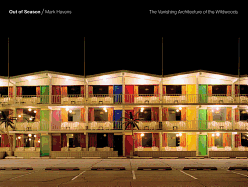
| Publisher: | Booth-Clibborn Editions | |
| Genre: | Architecture, Buildings, United States, Regional, History, Northeast - Middle Atlantic (General), Contemporary (1945 -), Photography, Travel, Architectural & Industrial, General, Public, Commercial & Industrial, Collections, Catalogs, Exhibitions | |
| ISBN: | 9781861543783 | |
| Pub Date: | August 2016 | |
| Price: | $55 |
| Art & Photography |
by Mark Havens

| Publisher: | Candlewick Studio | |
| Genre: | Photography, Techniques, Equipment, General, Photoessays & Documentaries, Collections, Catalogs, Exhibitions | |
| ISBN: | 9780763692506 | |
| Pub Date: | October 2016 | |
| Price: | $45 |
| Art & Photography |
by David Ellwand
Professional photographer David Ellwand collects vintage photographic equipment. In this dazzling coffee-table book, he shares more than 100 cameras from his treasure trove, as well as the images created with them. The full-color, glossy pages packed with diverse brands, styles and ages of cameras are sure to tantalize any photography buff. For younger shutterbugs, the film camera may be a foreign monster, but a love of seizing moments in time through pictures is all that's needed to find beauty in these classic machines. The creative approaches to his art, both in the shooting and the processing of snapshots, is wondrous to behold for anyone, but inspiring and motivating for those who appreciate the craft. From the various Kodak Brownie models to the Ricoh Rangefinder, this museum-quality collection casts a wide scope. From the double lens to the pinhole camera, the approaches to capturing light on film are breathtaking. Retro Photo is a visual delight. --Jen Forbus, freelancer

| Publisher: | Wienand Verlag | |
| Genre: | Art, General, History, Collections, Catalogs, Exhibitions, Jewish | |
| ISBN: | 9783868323153 | |
| Pub Date: | September 2016 | |
| Price: | $69.95 |
| Art & Photography |
by Eliad Moreh-Rosenberg, editor
With descriptions and introductory essays given in German, Hebrew and English, the pieces range from realistic to escapist, representational to allegorical: a watercolor butterfly lighting on hard ink lines of barbed wire against a ghostly background; a pair of women in brightly colored summer dresses seemingly floating, picnic baskets in hand, above a meadow. Meant to humanize the victims of the Holocaust, the severity of the collection seethes with profound anger. Even gentleness is rendered caustic. --Zak Nelson, writer and bookseller
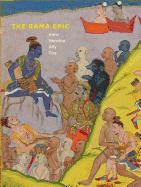
| Publisher: | Asian Art Museum of San Francisco | |
| Genre: | Sacred Writings, Art, Indian & South Asian, Religion, Hinduism, History, Asian | |
| ISBN: | 9780939117765 | |
| Pub Date: | October 2016 | |
| Price: | $50 |
| Art & Photography |
by Robert P. Goldman, Sally J. Sutherland Goldman, Philip Lutgendorf, Forrest McGill, editor
The Ramayana is a heroic epic, an important Hindu scripture and a cultural touchstone for the peoples of South and Southeast Asia. Over the millennia, it has inspired poets, artists, dramatists, dancers and, more recently, movie directors and video game designers. In The Rama Epic: Hero, Heroine, Ally, Foe, San Francisco's Asian Art Museum explores the Ramayana as both story and social model, using art objects created over a period of 1,500 years from many different countries.
Rather than overwhelming an audience unfamiliar with the sprawling epic, The Rama Epic focuses on the four characters who stand at its heart: Rama; his wife, Sita; the monkey-god Hanuman; and the demon Ravana. Each character is the subject of two thoughtful essays. One examines the changing nature of the character's role as hero, heroine, ally or foe; the second examines the character's basic iconography. The end result is a visual feast that allows readers to engage with and make the Ramayana their own. --Pamela Toler, blogging at History in the Margins
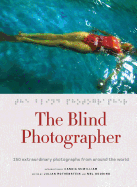
| Publisher: | Princeton Architectural Press | |
| Genre: | Photography, Biography & Autobiography, Techniques, General, Subjects & Themes, Individual Photographers | |
| ISBN: | 9781616895235 | |
| Pub Date: | September 2016 | |
| Price: | $45 |
| Art & Photography |
by Julian Rothenstein, editor
At a time when anyone with a cell phone is a photographer, it takes the sensitivity and vision of the blind to see that a picture can be much more than a Snapchat cat-on-a-lap or celebrity selfie. In The Blind Photographer (its title embossed in Braille on the jacketless cover), editor Julian Rothenstein selects striking examples from dozens of blind or partially sighted photographers, and bookends them with a thoughtful introduction from once-blind novelist Candia McWilliam and a heartfelt afterword by Jorge Luis Borges, who was blind for the last 30 years of his life.
After a chapter answering the obvious question "How Do They Do It" (with helpers, by touch and slowly), the splendid array of mostly color plates captures sensitive portraits, still lifes, panoramas and dramatic set pieces. Particularly arresting are Gerardo Nigenda's black-and-white nudes overlaid with Braille poetry that suggests love's "sensual tactility." Borges best summarizes the power behind these images: "in the good of heaven there can also be darkness... who can know himself more than the blind man?" --Bruce Jacobs, founding partner, Watermark Books & Cafe, Wichita, Kan.
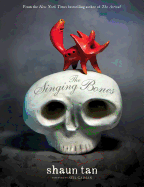
| Publisher: | Arthur A. Levine/Scholastic | |
| Genre: | Fantasy & Magic, Monsters, General, Juvenile Fiction, Fairy Tales & Folklore | |
| ISBN: | 9780545946124 | |
| Pub Date: | October 2016 | |
| Price: | $24.99 |
| Children's & Young Adult |
by Shaun Tan, foreword by Neil Gaiman
Tan appreciates the ambiguity of fairy tales and how they are "strung between the real and unreal, the literal and impossible, convincing and absurd." All of this shines through Tan's powerful, enigmatic papier-mâché and clay sculptures he describes as orange-like in size and "much inspired by Inuit stone carvings and pre-Columbian clay figurines." A marvel, a masterpiece, a must. --Karin Snelson, children's & YA editor, Shelf Awareness